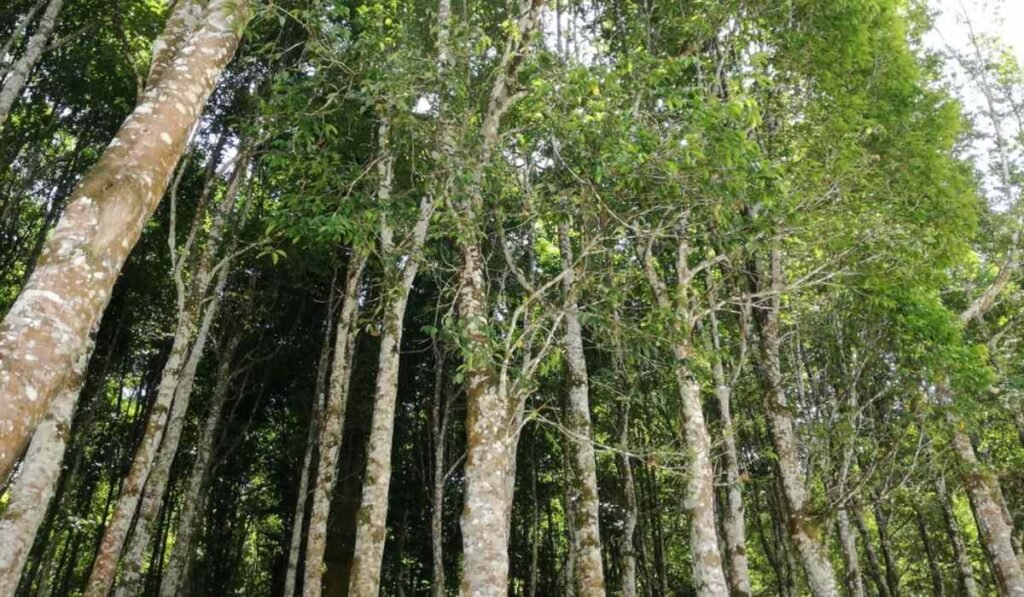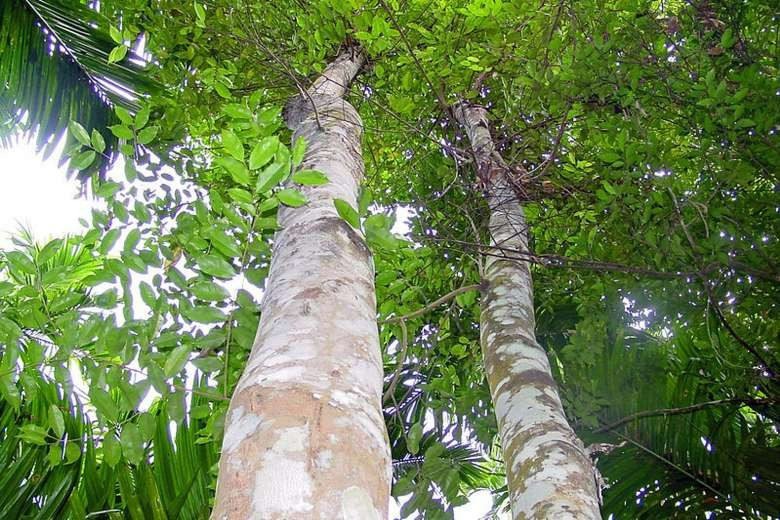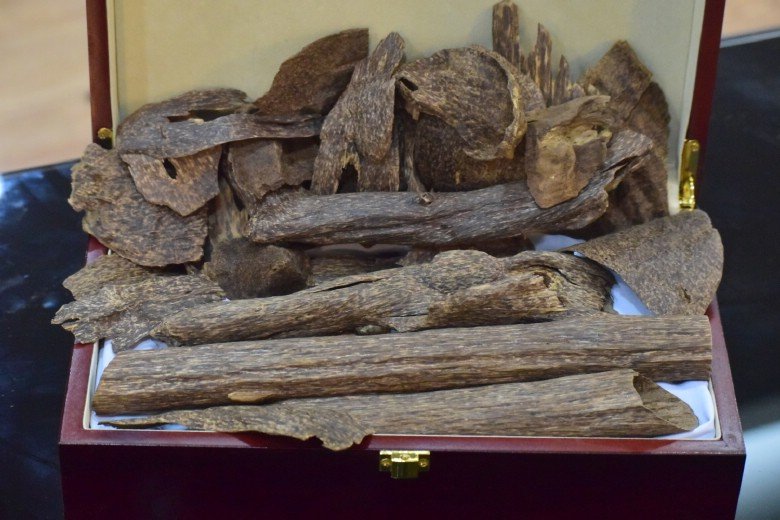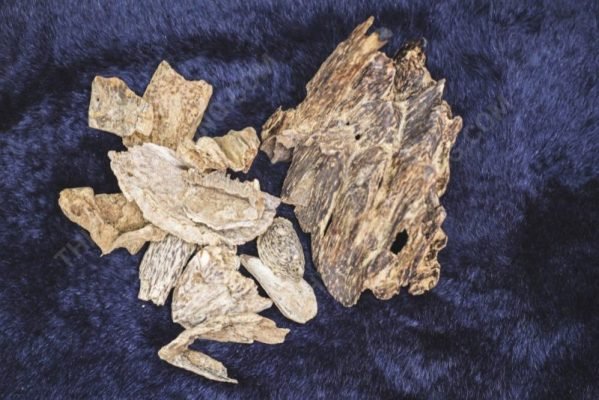Agarwood, often referred to as the “wood of the gods” and known as aloe wood in India, is a highly prized resinous wood that forms within certain species of the Aquilaria tree.
Known for its distinctive fragrance, agarwood has been cherished for centuries for its use in perfumes, essential oils, incense sticks, and traditional medicine.
Its rarity and the intricate process of formation make it one of the most valuable natural products in the global market.
What is Agarwood?

Agarwood, often referred to as oud, is a highly prized resinous wood known for its captivating fragrance. It originates from certain Aquilaria species, large evergreen trees native to Southeast Asia.
Unlike typical wood, agarwood’s aroma develops as a defense mechanism when the tree is infected with a specific type of mold or infested by insects.
In response to the attack, the tree produces a fragrant resin that gradually infiltrates the heartwood. This resinous heartwood, known as agarwood, is dark, dense, and possesses a complex, highly sought-after aroma. The quality and fragrance of agarwood vary greatly depending on factors like the species of tree, geographical location, and the duration of infection.
Where Does Agarwood Grow?

Agarwood trees thrive in tropical regions, particularly in Southeast Asia, including countries like India, Vietnam, Thailand, and Malaysia.
Shakomato has Agarwood plantations in Biswanath Chariali, Assam. The Soil of Assam provides an ideal environment for our cultivation of Agarwood due to its rich biodiversity and humid climate.
It is very close to Guwahati in Assam and you can see the plantations yourself by visiting this address:
P4M6+835, No.2 Chalia, Assam 784175, India.
You can find it on google maps by visiting this link.
Other than this, neighboring regions like Papua New Guinea and parts of South India also support agarwood growth.
How is Agarwood Formed?

Agarwood forms as a defense mechanism when Aquilaria trees are infected by fungi or bacteria.
This infection triggers the tree to produce a fragrant wood resin to protect itself. Over time, the resin saturates the heartwood, transforming it into the dark, aromatic agarwood we value so highly.
This natural process can take years and requires careful attention to ensure high-quality resin production.
What is the Significance of Agarwood?
Agarwood holds immense cultural, religious, and economic importance across various regions:
- Cultural and Religious Significance: In many cultures across Southeast Asia and the Middle East, agarwood is burned during spiritual ceremonies for its calming aroma. It is mentioned in Ayurvedic medicinal texts for its therapeutic properties.
- Uses in Perfumes and Essential Oils: Agarwood oil is a cornerstone of luxury perfumery due to its rich and long-lasting fragrance.
- Economic Value: The global market for agarwood products is highly lucrative due to its high demand and limited supply. A single kilogram of wood or oil can fetch substantial prices internationally.
Is Agarwood Sustainable?

The sustainability of agarwood production has become a pressing concern due to overharvesting and habitat loss. Wild Aquilaria trees are now classified as endangered species under Appendix II of CITES (Convention on International Trade in Endangered Species).
However, sustainable farming practices are emerging as a solution to meet demand while conserving natural resources.
How is Agarwood Cultivated?

Cultivating agarwood involves creating favorable conditions for resin production. While agarwood can form naturally in the wild, it is a rare occurrence. Plantation cultivation allows for more controlled and sustainable production methods.
One common technique is artificial inoculation, where young trees are deliberately infected with the fungus that triggers agarwood formation. This method helps to produce agarwood more efficiently and sustainably compared to relying solely on natural occurrences.
Natural Growth Vs. Plantation Cultivation
There are key differences between agarwood obtained from natural growth and plantation cultivation. Naturally formed agarwood is rare and highly prized due to the complex aroma that develops over many years, influenced by the tree’s natural environment.
However, the high demand and overharvesting of wild trees make natural agarwood unsustainable. Here’s where plantation cultivation plays a vital role in meeting the demand while ensuring the species’ survival.
Plantation cultivation offers a more controlled environment and utilizes techniques like:
- Fungal inoculation to induce resin production.
- Sustainable harvesting methods less damaging to the trees.
- Regulated harvesting to ensure the long-term health of the plantations.
At Shakomato, we take pride in cultivating agarwood sustainably, ensuring a balance between meeting market demand and conserving natural resources. Our plantations are carefully managed to mimic the trees’ natural environment while implementing ethical harvesting practices.
Sustainable Agarwood Farming Practices
Implementing sustainable practices is important for the long-term well-being of both the agarwood industry and the Aquilaria species.
Shakomato’s Sustainable agarwood production farming involves a holistic approach, focusing on responsible harvesting techniques and minimizing the environmental impact.
Sustainable methods involve planting Aquilaria trees in degraded lands or rural areas while ensuring that resin extraction does not deplete resources. These practices benefit local communities by creating jobs and preserving biodiversity.
Is Agarwood Cultivation Legal Everywhere?

The legality of agarwood cultivation varies by region due to its status as an endangered species. While countries like India have regulated agarwood farming under strict guidelines, international trade requires permits to prevent exploitation of aromatic plants.
Farmers must adhere to local laws to ensure compliance with conservation efforts.
Why is Agarwood Important?

Agarwood’s importance stems from its multifaceted nature.
It is deeply rooted in cultural and religious traditions, valued for its aromatic properties, and holds economic significance for local communities. The wood’s alluring fragrance and the essential oil derived from it have made it highly sought-after for centuries.
This demand makes sustainable production and ethical sourcing important to protect the future of these valuable trees while respecting the cultural heritage they represent.
Cultural and Religious Significance
Agarwood, also known as “oud,” holds a significant cultural and spiritual value in East Asia and the Middle East, where it has been revered for centuries. This aromatic resin is considered a symbol of divinity and purity, often used in religious rituals, meditation practices, and traditional medicine.
The rich, woody scent of agarwood is believed to have therapeutic properties and medicinal uses that promote relaxation and mental clarity. In traditional medicine, agarwood is used to treat various ailments such as digestive issues, respiratory problems, and skin conditions.
Its rarity and unique fragrance have made it highly sought after for perfumes, incense, and spiritual ceremonies across different cultures, especially in the use of agarwood. The deep-rooted significance of agarwood in these regions reflects its enduring allure and timeless appeal.
Uses in Perfumes and Essential Oils
Agarwood oil, derived from agarwood chips, is highly sought after in the fragrance industry for its intricate chemical composition that produces distinctive aromatic profiles.
The oil is prized for its rich and exotic scent, making it a popular choice for luxury perfumes and colognes. Its complex blend of compounds adds depth and character to fragrances, creating a sense of sophistication and elegance.
Agarwood oil is often referred to as “liquid gold” due to its rarity and exquisite fragrance notes, which can range from woody and earthy to sweet and floral. Perfume houses around the world covet agarwood oil for its ability to elevate scents and evoke a sense of luxury and exclusivity.
Economic Value of Agarwood
Agarwood, renowned for its scarcity, stands out as one of the most costly woods on a global scale, with yields reaching kg of wood from specific trees. Its cultivation not only offers substantial income prospects for rural farmers but also plays a pivotal role in international trade.
The demand for agarwood stems from its versatile uses in luxury perfumes, incense, and traditional medicine. Due to its limited availability and the time-consuming process required to extract the resin, agarwood commands high prices in the market.
Its unique fragrance and cultural significance have made it a prized commodity in various parts of the world, leading to sustainable economic opportunities for communities involved in its production.
Shakomato’s efforts are being made to promote responsible agarwood harvesting practices to ensure its conservation for future generations.
How Do I Store Agarwood?

Proper storage is essential to preserve the quality and fragrance of your agarwood. Given its value and the delicate nature of its aroma, the right storage conditions can significantly impact its longevity.
Here are some tips for storing agarwood:
- Cool, dark, and dry place: Humidity and direct sunlight can degrade the quality of agarwood.
- Airtight container: Store it in an airtight container to prevent the volatile compounds from evaporating and to protect it from pests.
- Wrapped in cloth: Consider wrapping your agarwood in a soft, breathable cloth like cotton or muslin before placing it in the container. This helps absorb any excess moisture.
How Do I Identify Genuine Agarwood?

Identifying genuine agarwood can be challenging, especially with the presence of counterfeit or adulterated products in the market.
However, there are a few methods commonly used:
- Visual Inspection: Genuine agarwood is typically dark, dense, and resinous. The color can range from dark brown to almost black, depending on the concentration of resin. You might also notice streaks or patterns in the wood, which are indicative of resin formation.
- Burn Test: A common method to test agarwood’s authenticity is the burn test. Heat a small piece of the wood with a lighter or incense burner. Genuine agarwood will release a sweet, woody, and long-lasting aroma when burned, while artificial scents will quickly dissipate or smell unpleasant.
FAQ’s
What are the main factors affecting agarwood quality?
Agarwood quality is influenced by the species of Aquilaria, geographical location, resin production (concentration and aroma), age of the tree, and post-harvesting processes.
The quality depends on factors like tree species (e.g., Aquilaria malaccensis or Aquilaria crassna), resin content, age of the tree, and method of resin formation (natural vs artificial inoculation).
Why is agarwood so valuable in the perfume industry?
Agarwood oil, known as oud, is highly prized for its distinctive fragrance, often described as woody, balsamic, and slightly sweet, making it a sought-after ingredient in luxury perfumes.
Agarwood oil contains rare chemical compounds that produce complex fragrances unmatched by synthetic alternatives.
What are the conservation statuses of agarwood-producing species?
Many agarwood-producing species are considered endangered due to overharvesting and habitat loss. International trade is regulated under CITES to protect these valuable species.
Most wild Aquilaria species are listed as endangered due to overharvesting. Conservation efforts focus on plantation cultivation to reduce pressure on wild populations.
Can Agarwood Grow Outside Its Native Regions?
Agarwood can grow outside its native regions, but it thrives best in specific conditions. Factors like climate, soil type, and care play crucial roles in successful cultivation. Understanding these requirements is essential for cultivating agarwood beyond its native regions.
While native to tropical Southeast Asia, Aquilaria trees can adapt to similar climates in other regions like Papua New Guinea or parts of Africa with proper care.
Conclusion
Agarwood, a precious commodity with rich cultural and economic value, thrives in specific regions under optimal conditions, including agarwood-producing areas, contributing to the sustainable production of agarwood particularly in the Shakomato’s plantation areas in Assam.
Agarwood’s growth, significance, and sustainable cultivation practices are important. This aromatic resin holds not just economic importance but also plays a significant role in various traditions and industries.
Agarwood represents a unique blend of nature’s resilience and human ingenuity. From its humble origins as an infected heartwood to its transformation into fragrant resinous wood cherished worldwide, it embodies both ecological significance and economic potential.
Shakomato is dedicated to embracing sustainable farming practices and respecting legal frameworks ensures that this “resinous treasure” continues enriching lives while preserving our planet’s biodiversity for generations to come.

